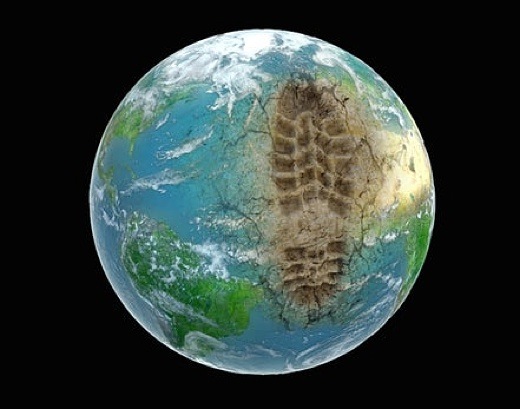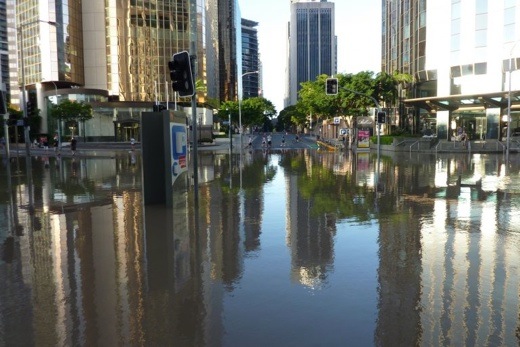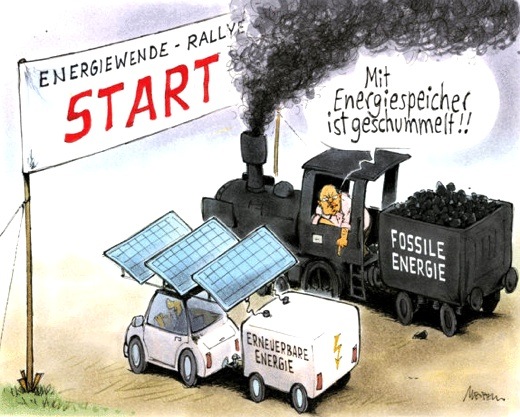SUBHEAD: I can bear witness and refuse to close my heart. I can continue to love even when it hurts like hell.
By Elizabeth West on 22 March 2018 for Common Dreams -
(
https://www.commondreams.org/views/2018/03/21/love-and-loss-anthropocene)
 Image above: The footprint of humans on the Earth is getting uglier. From (https://newatlas.com/anthropocene/45151/).
Image above: The footprint of humans on the Earth is getting uglier. From (https://newatlas.com/anthropocene/45151/).
What can we do? We are without doubt in an historically unique and incredibly challenging position. The Anthropogenic extinction is here, now. It is not something we are anticipating or awaiting. It is upon us.
Today, we are in it, watching the life we have known unravel on a hundred different fronts. And I find myself asking with crazy-making regularity: how can I—one ordinary human amongst 7.5 billion—honor this extraordinary time with whatever gifts and goods I happen to be carrying?
Many of us are posing similar questions to ourselves, to one another. These are my own very personal musings of this moment, shared in the hope that they might spark or support others’ explorations.
I expect that there are as many answers as there are humans willing to ask; we all must find our own way, our own truth in these times.
I experience a lot of gnawing low-level anxiety of late, I have frequent bursts of anger and I regularly skirt the precarious edges of depression.
It is not easy for any of us to hold in full consciousness the massive losses—and concomitant suffering– that are already underway, not to mention all those which are almost certainly just around the next bend.
I try, like so many of us do, to balance awareness and honest acknowledgement of our impending collective demise with kindness and compassion. I work hard to avoid becoming completely subsumed by grief, to stay in the moment. It isn’t fun—or particularly functional—to wallow in sorrow.
More importantly, I don’t want to be lost in my own inoculating darkness when there is relatively little time left to manifest the best of who it has been given to me to be.
I continue to believe that among the few meaningful actions left to us may be the choice to seek within ourselves love and courage and connection, even—and especially—in the midst of devastation.
But grief arises as part of that commitment. We know: loving almost always entails loss. To live with an open heart means being present for the slings and arrows.
Grief is part of the journey that lies ahead for all of us, should we choose to make it in consciousness. And sometimes the grief captures my attention in ways that take me completely by surprise.
As a parent, I am ever aware of the legacy of our choices, all that we have made impossible for our children and grandchildren.
Easiest to see are the larger and most tangible of consequences —the horrifying prospects of global warming, climate chaos, habitat destruction, rising and acidifying seas, breakdown of civil order, war and…extinction.
Any human under 50 today—and all the other innocent beings on the planet—are facing a life immeasurably more difficult than the one I was granted.
Unbearable at times, I do try not to let the looming calamity keep me small or shut down, from delighting in the advent of another spring, from watching the birds with wonder and gratitude.
Nature, though brutally ravaged by human greed, still manages to offer deep sustenance, an unbeatable and incredibly generous antidote to the fear and anger and sadness that are afoot everywhere in these times.
A few weeks back, out walking in the unseasonably warm weather, I came upon a gnarled old apple tree, in full bloom. As I always do, I leaned in for a good whiff, a deep receiving of the tree’s offering.
My own personal ‘madeleine,’ the scent instantly conjures for me the glory of infinite possibility, the breathtaking capacity of human beings to make beauty, to create meaning, and to love heroically.
Twined together forty-three years ago, that particular fragrance and the aliveness I felt back then, on the cusp of adulthood, cannot be separated.
At seventeen, I embarked ebulliently on the adventure of my life. My best friend and I moved into our first apartment in January, and we got jobs that paid us the minimum wage of $2.10/hour, to cover the rent.
We bought big sacks of bulgur and millet to eat, and I brought home as many leftovers as I could from the college dining hall where I made salads all day.
As spring arrived, our landlady gifted us with armloads of beet greens thinned from her large garden, and then rhubarb stalks as they emerged. We didn’t know what to do with them, but we learned. Turning down free food was not really an option.
Besides, we were saving for our very own telephone, and in a couple of months we succeeded in getting the necessary cash together, and proudly found ourselves waiting for the calls to come in on the brand new yellow wall phone.
Our apartment comprised the second floor of a farmhouse nestled in the midst of a rambling apple orchard. The windows ran almost floor to ceiling, filling our living room with incredible light in the mornings, and being up high, we could see the purple shadows of the Catskills in the distance as we washed dishes in the early evenings.
The shabby furniture, the makeshift kitchen, the ancient bathroom—none of these eroded one iota our wonder and delight at the breathtaking freedom and promise of our lives.
We filled the place with too many plants, got a cat and a puppy, and spent a great deal of time dreaming. I was going to be a French chef. Maybe a Classics scholar, rendering obscure Latin poetry into meaningful contemporary verse. Possibly a shaman: I’d learn to fly and heal and see far into the future, into the very meaning of life.
And of course, we were both going to find love that surpassed even our literature-fueled dreams. Almost everything we imagined seemed within reach. After a few beers, listening to Mozart’s piano concertos and then The Velvet Underground and finally, Laura Nyro, we would weep for the unfathomable breadth of potential and possibility of what lay ahead, for the bittersweet knowledge that it would not, could not, all come to pass.
We were so fortunate.
As March drew on, something unexpected but utterly foreseeable occurred. The orchard burst into bloom. Everywhere, everywhere, the pale pink blossoms called to the bees and the scent, subtle but persistent, filled the air, drifted in the windows we opened to feel the spring on our skin.
Although we knew it was not especially ethical, knew that the farmer counted on each of those flowers to mature into apples for sale, we stole out in the night anyway and cut massive sprays of the branches to bring inside, sticking them in jars and arranging them in every one of our three rooms.
Something beyond reason commanded us to immerse ourselves in this amazing efflorescence, this unlooked for gift from the earth.
To bury our noses in the blossoms and sink gratefully into olfactory celebration of the new life that spring promises, the beginnings, the vastness of what might be.
We were so innocent; we had no idea.
Like many of my time and place, I ‘grew up’ in fairly short order. I made choices, and with each choice, I shut the door on other options.
My trajectory, though never straight, became clearer. I learned about limits, and despite protestations both internal and external, I came to accept that there were things I would never, could never, do or be.
The lingering sorrow of this is balanced somewhat by the knowledge that I did manage some of my dreams, modestly understood. Following those dreams was a privilege that I took mostly for granted. It was a privilege that many of my contemporaries never had, and which few, if any children today will claim.
Hard on that moment a few weeks ago, inhaling the scent of apple blossoms and being overcome with the visceral memory of unlimited potential, came the grief. What have we done? Oh, what have we done?
As a species, we have been unable to meet the challenges posed by our own misguided attachment to growth. While the apple blossoms in the orchard around my first apartment faded and began their transformation into fruit (duly sprayed, no doubt, with stockpiled DDT), the fifth annual Earth Day was observed.
It is impossible to say whether we might have changed the course of things enough if we had paid attention to what was already known then, but the point is moot. We didn’t grasp the urgency, we didn’t act. And for the main, we still do not, even as the world burns.
Life, such as it is, goes on, and all of us try in our own ways to live it without undue pain or suffering. In the developed world, those with the means drive, eat, charge our phones and computers, heat and cool our homes at minimum.
When we can, most of us look for release and entertainment, travel a bit, and take in the beauty of our planet while we still can.
I really do try not to judge anyone’s choices, much less their coping strategies. After all, I have done my bit to contribute to this situation, I am far from blameless.
We are facing epic disaster, extinction in all probability, and although I have not always done my best for this planet and its inhabitants, it feels incumbent upon me to do so now.
The truth is that these are desperate and utterly unusual times; no one really knows how to navigate them, there are no experts at walking gracefully into annihilation. We are making it up as we go and have only our own vast, and often ignored, inner resources to guide us.
For me, part of the answer lies in feeling it all, in refusing to turn away from what is before me. To look both the beauty and the horror head on, to keep my heart open, no matter what it finds. Some days this leaves me enveloped in a sizzling joy, encountering the glories of this world, human and otherwise.
Other days, that same display plunges me into despair, as I sense the transient, ebbing nature, the impending loss of all that has been so good and beautiful.
On those days, there are moments when the hellish scenarios that populate my imagination take over and scare the shit out of me, but sometimes I simply long to apologize. To bow down and beg forgiveness, to offer up my sincerest regrets.
To the waters, the dolphins, the oaks, the salamanders, the children. All beloved and all endangered.
I was never especially profligate with my resources, but along with many others, I was entrusted with stewardship of this planet–my home. I did not do enough and I bear responsibility for the consequences of our shared indifference to the fate of the planet.
Leaving aside any breast-beating, which accomplishes less than nothing at this point, I am simply incredibly sorry for what has happened, and what will inevitably happen to the trillions of beings who will not have the chance to make their own choices.
I am indescribably sorry for the destruction, the suffering, the pain that are already visited upon the many as a result of human action/inaction, and which will undoubtedly become universal in the not too distant future.
Our insistence upon having everything has ironically set us upon a journey toward an era of great loss.
Some of what we will have to relinquish is painfully clear already, as we see cities and small nations burn and/or wash away, as we find ourselves increasingly donning masks so as not to die of the very air we must breathe, as we find cesium 137 in our fish, RoundUp in our grains, microplastics in our waters.
These are the obvious costs. The larger lamentations as we walk the road to extinction.
But there are other losses not so readily apparent or dramatic, for which I weep as well. They will make themselves known as we continue our collective walk down this road, the one we have chosen—consciously or not—for our species, our planet and most of the other beings with whom we share the earth.
Today, a lesser lamentation. There were, according to the United Nations Population Fund, 1.8 billion young people in the world in 2014. More now, to be sure, but we know that there are at least that many young human beings in the flowering of their lives, readied by time and nature to imagine, to dream, to believe in the future and all it might hold.
That which was so heady and life affirming for me is denied them.
The future is no longer a place where vision can forge reality, where longing coupled with determination can lead to almost anything imagined. Admittedly, this isn’t nearly so dire as losing life or limb or family or home, but it matters.
Prompted by the precious scent of this year’s apple blossoms, I am quietly grieving this little loss: the end of the future as something the young can dream into reality, take by storm, make their own. Never an option for all, now looking obsolete and unattainable for everyone. Even those with a luxury bunker in New Zealand.
And so I apologize to those young people whose lives will almost certainly be robbed of the richness, the freedoms, the potential—the very future—which I enjoyed. I cannot substantively change what lies ahead; I am afraid it is too late for that.
But I can own my part in creating it. And, perhaps more meaningfully, I can try to be an honest witness, I can find the courage to look without flinching, no matter how painful it gets. I can decline to turn away, I can refuse to close my heart, I can continue to love even when it hurts like hell.
It isn’t much, it isn’t nearly enough, but in concert with my unfettered delight in the return to my neighborhood of a breeding pair of ospreys, it is what I can wholeheartedly offer today.
.







 ,
,
